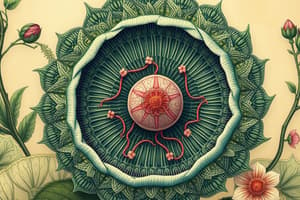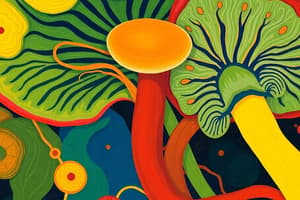Podcast
Questions and Answers
What is the primary function of the lac operon in E. coli?
What is the primary function of the lac operon in E. coli?
- To regulate the expression of genes involved in glucose metabolism
- To activate the transcription of genes involved in protein synthesis
- To induce the production of insulin in response to high glucose levels
- To repress the expression of genes involved in lactose metabolism (correct)
What is the term for the process by which water moves through a plant, from the roots to the leaves, and is then released into the air as water vapor?
What is the term for the process by which water moves through a plant, from the roots to the leaves, and is then released into the air as water vapor?
- Photosynthesis
- Osmosis
- Respiration
- Transpiration (correct)
What is the name of the process by which genetic information is transferred from RNA to DNA?
What is the name of the process by which genetic information is transferred from RNA to DNA?
- Reverse transcription (correct)
- Replication
- Translation
- Transcription
What is the term for the phenomenon in which a single gene can have multiple distinct effects on an organism's phenotype?
What is the term for the phenomenon in which a single gene can have multiple distinct effects on an organism's phenotype?
What is the name of the process by which an organism's genetic information is used to create a protein?
What is the name of the process by which an organism's genetic information is used to create a protein?
What is the term for the movement of genes from one population to another, resulting in an increase in genetic variation?
What is the term for the movement of genes from one population to another, resulting in an increase in genetic variation?
What is the name of the process by which an organism's environment selects for certain traits, leading to an increase in fitness?
What is the name of the process by which an organism's environment selects for certain traits, leading to an increase in fitness?
What is the term for the study of the structure, function, and evolution of the genome?
What is the term for the study of the structure, function, and evolution of the genome?
What is the process by which the pollen grain germinates on the stigma of a flower?
What is the process by which the pollen grain germinates on the stigma of a flower?
Which of the following is an example of a post-fertilization event in plants?
Which of the following is an example of a post-fertilization event in plants?
What is the term for the development of an embryo from an unfertilized egg cell?
What is the term for the development of an embryo from an unfertilized egg cell?
Which of the following is NOT a mode of asexual reproduction?
Which of the following is NOT a mode of asexual reproduction?
What is the term for the study of the inheritance of traits?
What is the term for the study of the inheritance of traits?
Which of the following is an example of a chromosomal disorder in humans?
Which of the following is an example of a chromosomal disorder in humans?
What is the term for the process by which a sperm fertilizes an egg cell?
What is the term for the process by which a sperm fertilizes an egg cell?
Which of the following is a method of assisted reproductive technology?
Which of the following is a method of assisted reproductive technology?
Study Notes
Reproduction in Organisms
- Reproduction is a characteristic feature of all organisms for the continuation of species.
- There are two modes of reproduction: Asexual and Sexual reproduction.
- Asexual reproduction modes: Binary fission, Sporulation, Budding, Gemmule, Fragmentation, and Vegetative propagation in plants.
Sexual Reproduction in Flowering Plants
- Flower structure is essential for sexual reproduction.
- Development of male and female gametophytes occurs in flowering plants.
- Pollination occurs through various agencies, including wind, insects, and animals.
- Outbreeding devices and Pollen-Pistil interaction are crucial for successful fertilization.
- Double fertilization leads to the development of endosperm and embryo.
- Post-fertilization events: Development of seed and formation of fruit.
- Special modes of reproduction: Apomixis, Parthenocarpy, and Polyembryony.
- Seed and fruit formation are significant for the continuation of species.
Human Reproduction
- Male and female reproductive systems are essential for human reproduction.
- Microscopic anatomy of testis and ovary is crucial for gametogenesis.
- Gametogenesis involves Spermatogenesis and Oogenesis.
- Menstrual cycle is a vital process in female reproductive system.
- Fertilization leads to the development of embryo up to blastocyst formation and implantation.
- Pregnancy and placenta formation are essential for fetal development.
- Parturition and Lactation are critical for the birth and nourishment of newborns.
Reproductive Health
- Reproductive health is essential for preventing sexually transmitted diseases (STDs).
- Birth control is necessary, and methods include Contraception and Medical Termination of Pregnancy (MTP).
- Amniocentesis is a diagnostic tool for detecting genetic disorders.
- Infertility can be addressed through assisted reproductive technologies like IVF, ZIFT, and GIFT.
Genetics and Evolution
Heredity and Variation
- Mendelian Inheritance explains the principles of heredity.
- Deviations from Mendelism include Incomplete dominance, Co-dominance, Multiple alleles, and Inheritance of blood groups.
- Polygenic inheritance is an elementary concept.
- Chromosome theory of inheritance explains the role of chromosomes in heredity.
- Chromosomes and genes are essential for inheritance.
- Sex determination in humans, birds, and honey bees is influenced by genetic factors.
- Linkage and crossing over lead to genetic variation.
- Sex-linked inheritance is responsible for certain genetic disorders like Haemophilia and Colour blindness.
- Mendelian disorders in humans include Thalassemia, Chromosomal disorders, and Down's syndrome, Turner's syndrome, and Klinefelter's syndrome.
Molecular Basis of Inheritance
- DNA is the genetic material that carries genetic information.
- Structure of DNA and RNA is important for understanding genetic inheritance.
- DNA packaging, replication, and transcription are essential processes.
- Central dogma explains the flow of genetic information from DNA to proteins.
- Gene expression and regulation are critical for cellular processes.
- Lac Operon is a model for gene regulation.
- Genome and human genome project are essential for understanding genetic inheritance.
- DNA finger printing is a technique used for identification.
Evolution
- Origin of life is a complex and still-unresolved topic.
- Biological evolution is supported by various evidence, including Paleontological, Comparative anatomy, embryology, and molecular evidence.
- Darwin's contribution to the theory of evolution is significant.
- Modern Synthetic theory of Evolution explains the mechanisms of evolution.
- Variation (Mutation and Recombination) and Natural Selection are key drivers of evolution.
- Gene flow and genetic drift are important for population genetics.
- Hardy-Weinberg's principle explains the genetic equilibrium of populations.
- Adaptive Radiation is a phenomenon of rapid evolution.
- Human evolution is a significant area of study.
Biology and Human Welfare
Health and Disease
- Pathogens and parasites cause human diseases, such as Malaria, Filariasis, Ascariasis, Typhoid, Pneumonia, common cold, amoebiasis, and ringworm.
- Basic concepts of immunology include vaccines.
- Cancer, HIV, and AIDS are significant human health issues.
- Adolescence, drug, and alcohol abuse are important health concerns.
Improvement in Food Production
- Plant breeding, tissue culture, single cell protein, Biofortification, Apiculture, and animal husbandry are essential for improving food production.
Microbes in Human Welfare
- Microbes are used in household food processing, industrial production, sewage treatment, energy generation, and as biocontrol agents and biofertilizers.
Biotechnology and its Applications
- Genetic engineering (Recombinant DNA technology) is a fundamental principle of biotechnology.
- Applications of biotechnology in health and agriculture include human insulin and vaccine production, gene therapy, genetically modified organisms (Bt crops), transgenic animals, and biosafety issues.
- Biopiracy and patents are important concerns in biotechnology.
Ecology and Environment
- Organisms and environment are interconnected, with habitat and niche playing critical roles.
- Population and ecological adaptations are essential for understanding population dynamics.
- Population interactions, including mutualism, competition, predation, and parasitism, are important for understanding ecosystem dynamics.
- Population attributes, such as growth rate, birth rate, and death rate, are critical for understanding population dynamics.
- Ecosystems have patterns, components, productivity, and decompositions, with energy flow and pyramids of number, biomass, and energy.
Studying That Suits You
Use AI to generate personalized quizzes and flashcards to suit your learning preferences.
Description
Explore the different modes of reproduction in organisms, including asexual and sexual reproduction, and learn about the reproductive process in flowering plants.




